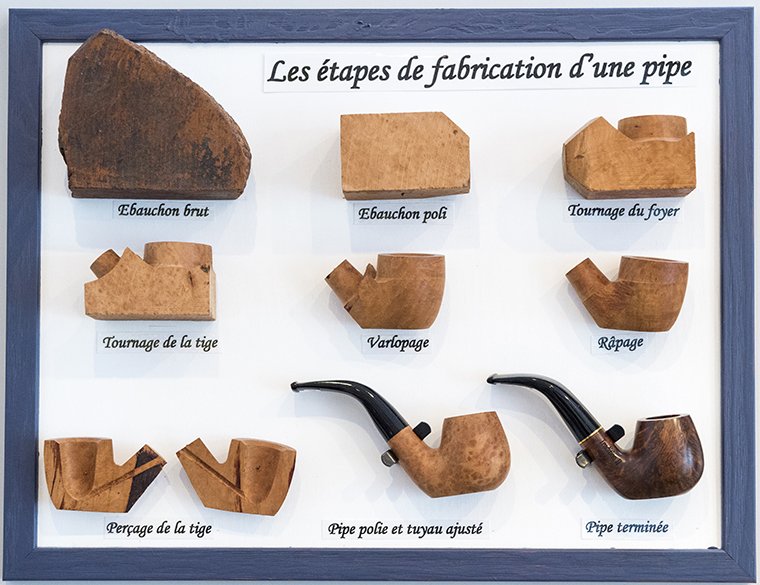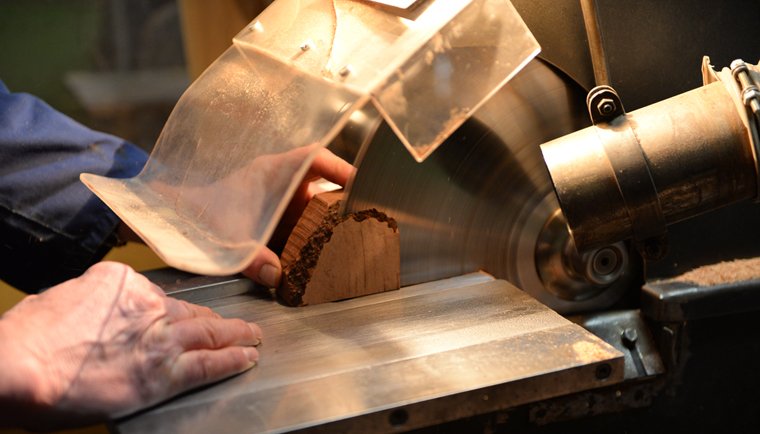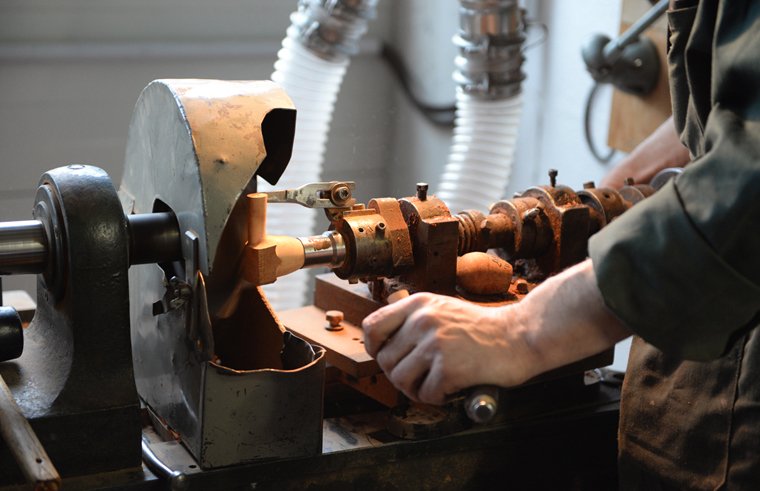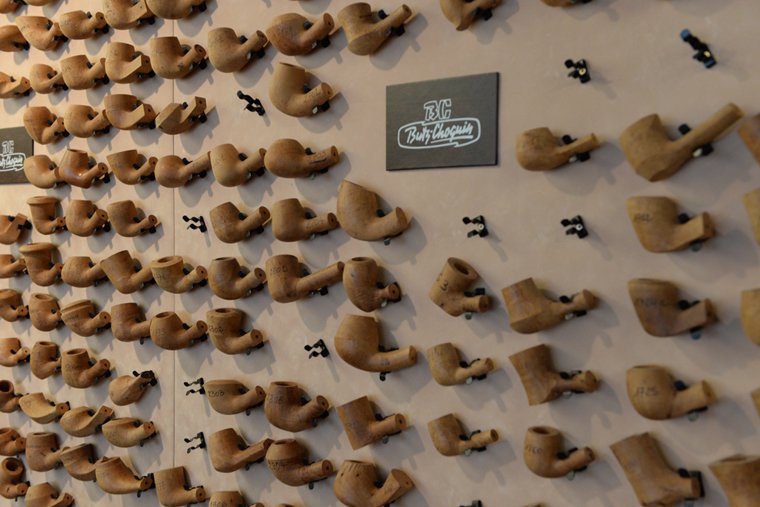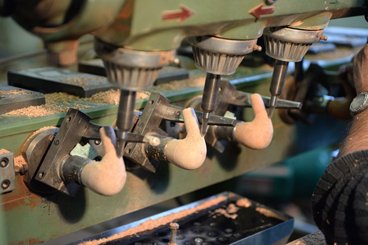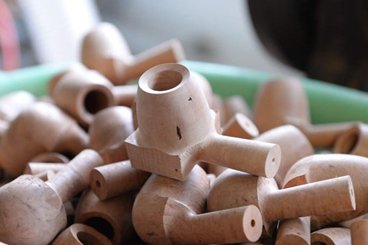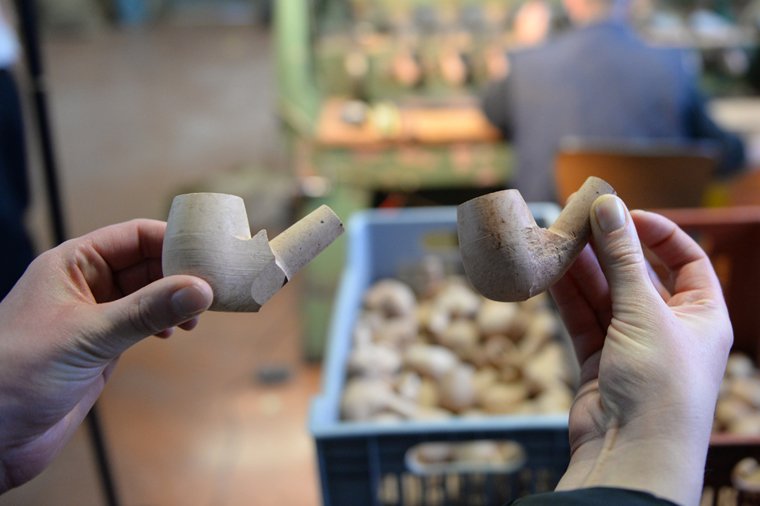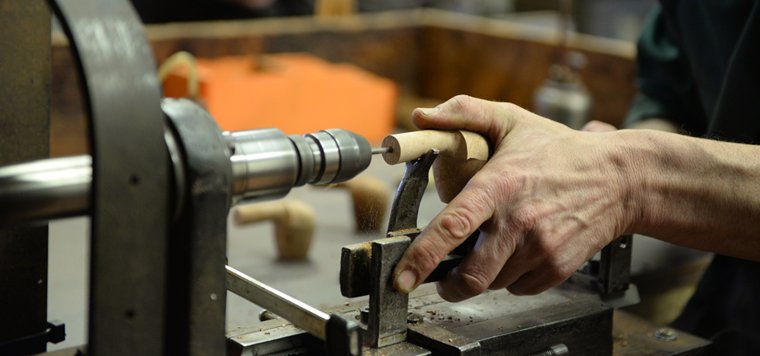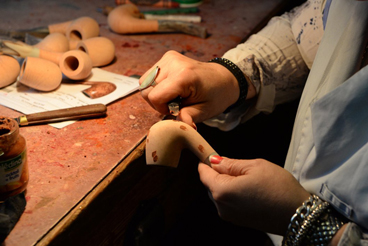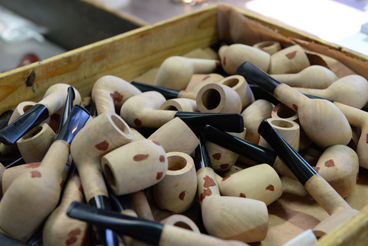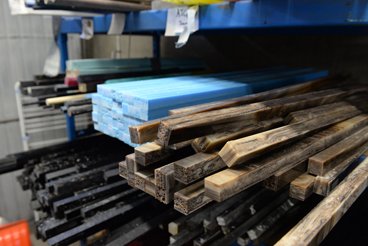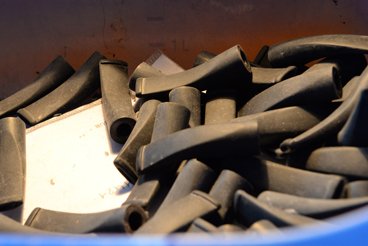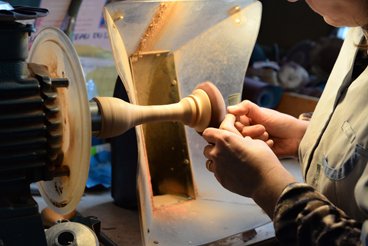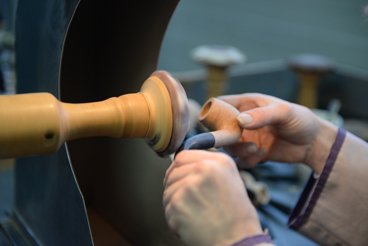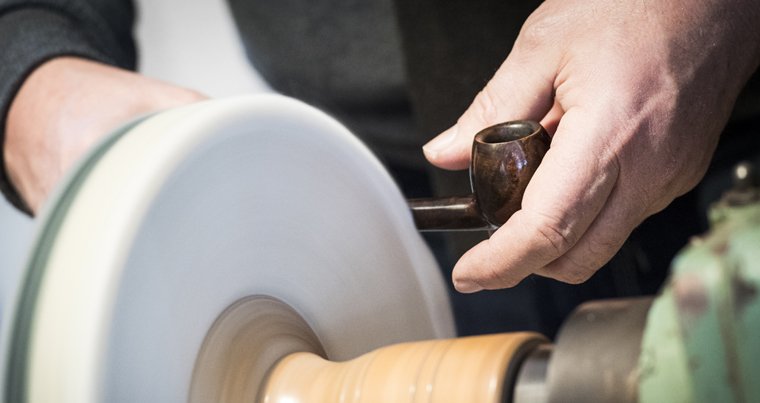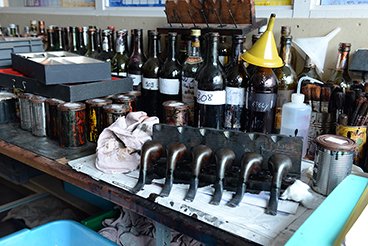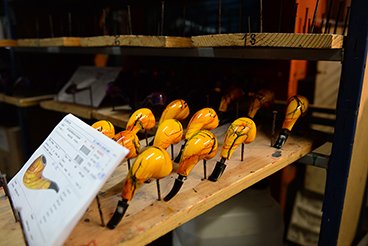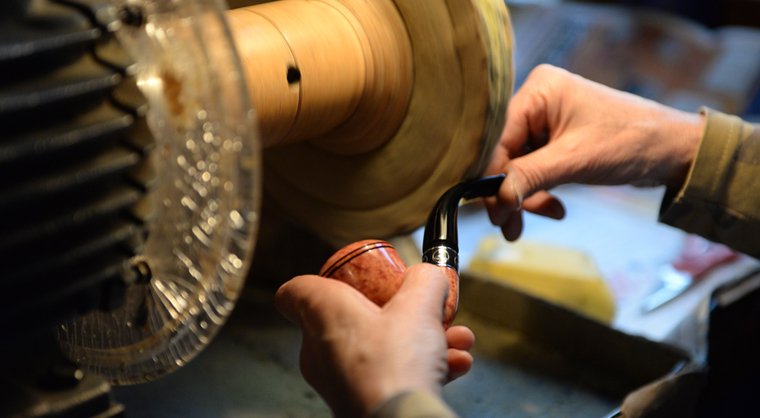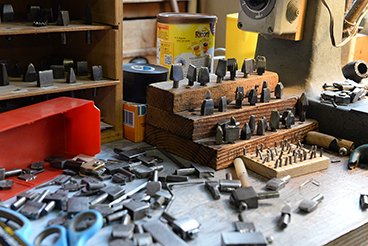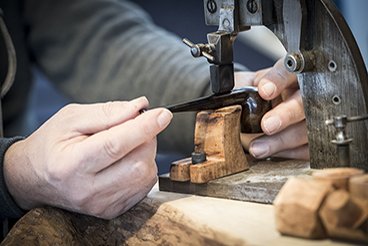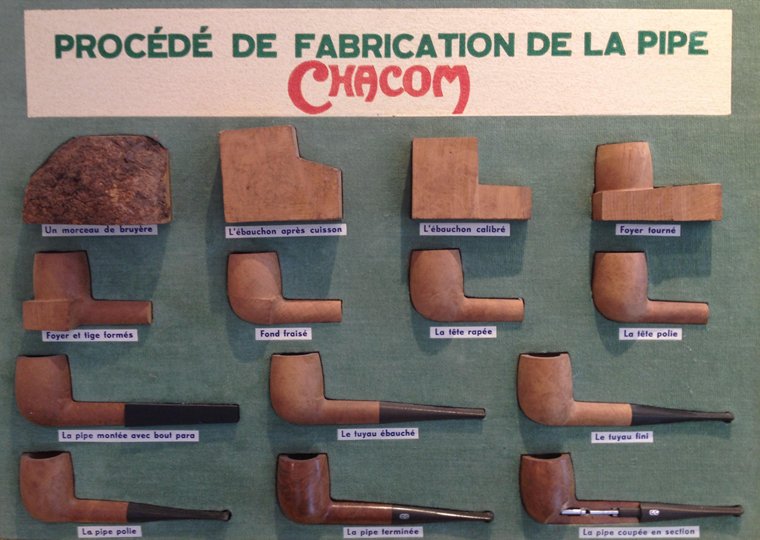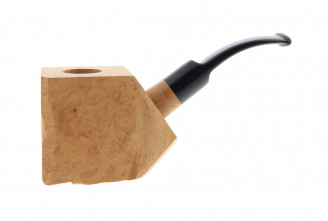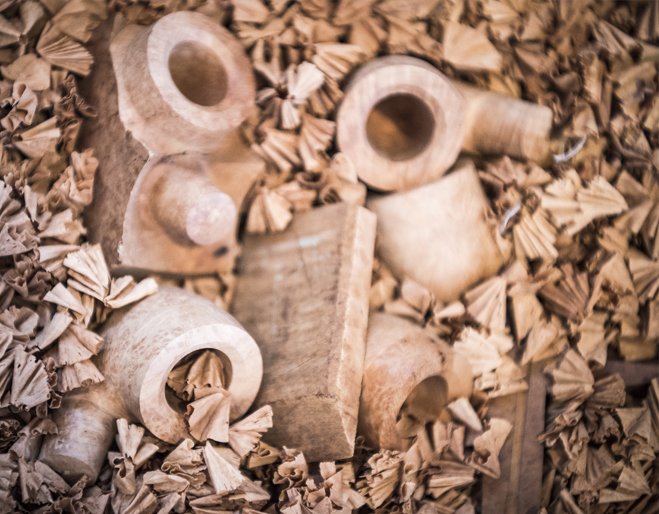
From briar stump to pipe:
Briar grows in the Mediterranean basin (Italy, Corsica, Spain and in the Maghreb countries...). This shrub has to grow for at least fourty years before its roots can be used. The extraction is carried out during winter period (between the end of October to the beginning of July). Apart from this period, and because of the hardness of the ground and the fact that the extracted stumps have to constantly be humidified, the grubbing up is impossible.
Extraction is a very difficult work, and you have to sneak in the bush to find briar, cut roots and branches to clear the stumps. Pending their transport to the factory, they have to be stored away from air and light to prevent them from bursting. It is therefore necessary to bury them or stack them and cover them with earth and branches to always keep them humid.
The stump is then transformed in a wooden board with the help of a circular saw, and then in blocks called "ebauchons". This operation requires in-depth knowledge and great skill. After shaping, ebauchons are put in boiling water for 10 to 12 hours to get rid of the juice. They are then put in bags so that they can be shipped without breaking.
Arrived in Saint-Claude, they are spread on racks where they will dry in the open air for 6 months to a year, depending on the season. Some manufacturers even use a dryer inside the factory so that the ebauchons can dry even quicker. Once dry, they are classified depending on their size, in order to determine what will each ebauchon become (a big or a small pipe?). A first sorting is therefore made: big ebauchons are good to be used and small ones put aside.
The birth of a pipe:
The creation of a pipe is a wonderful spectacle. How is it possible to get a so well worked product from a simple piece of wood? The control of execution, precision of movements, know-how... Attending to the birth of an artisanal pipe can only be witnessed with profound admiration.
The main manufacturing steps:
Everything is now ready to make a pipe... Then, let's begin and discover the main steps of the manufacturing of a briar pipe.
It should be noted that illustrative pictures of this blog article were made by us in the workshops of Chacom and Butz-Choquin's factories in Saint-Claude.
You will find below the eight main steps, but you have to know that each brand (or craftspeople) have their own way of doing it. For example, a major brand will have specific teams, each specialized in a step of the process. On the contrary, a craftsman (Pierre Morel from Saint-Claude) will be able to realize all the steps by himself...
Creating a pipe will always require the following steps:
- Calibrating
- The roughing out and planing
- Grating (milling)
- The drilling of the shank
- The assembly
- Polishing
- Dyeing and thinning
- The branding
1. Calibrating:
First step when creating a briar pipe! With the help of a circular saw, the worker will recut the ebauchons to give them a uniform thickness and height depending on the size of the model to make. The briar will therefore be divided into different categories depending on the necessary dimensions to be used for making future pipes.
2. The roughing out and planing:
It is now time to rough out and plane cut the piece of wood. Roughing out will create the shape of the bowl. The ebauchons therefore get in a phase of "turning" (also called "drilling" of the bowl). In the same way, the general shape of the shank will be made. This step could be called "planing".
You have to know that, at this stage, the ebauchon becomes an "ebauche".
Claire, La Pipe Rit
Obviously, the silhouette of the head will determine the shape of the pipe. At Butz-Choquin for example, each pipe shape (Poker, Volcano, Canadian, Pot...) is identified by a unique number. In England, at Dunhill "The White Spot", the same can be seen: the shape of a Dunhill pipe can be found thanks to the name of the model and its associated series of numbers.
3. Grating (milling) :
Grating involves removing (by milling) the excess of wood that remains between the two parts previously worked (bowl and shank) with the help of a milling cutter that has multiple blades turning at high-speed. To perfectly finish the milling process, this operation is also realized by hand with a file (grater).
You have to know that, at this stage, the "ebauche" becomes a "head".
Claire, La Pipe Rit
4. The drilling of the shank:
The head of the pipe starts to take shape, but there is still the drilling missing. The shank is therefore bored to join the drilled bowl (future tobacco chamber) to the end of the shank. Depending on the shape of the head, the drilling will be made in one or two passes. The drilling of a very bent model will be more difficult because it will be made in two times: a first one in the way of the shank so that the stem can fit in (and eventually a filter), and another one, more inclined, to reach the bottom of the bowl.
The drilling must be precise because it is important for a good pipe draft. It is the passage for the smoke.
Bastien, La Pipe Rit
The pipe has almost its final shape. A selector will then choose and sort through the different qualities of the briar. The heads will therefore be classified in different categories depending on the condition of the wood and the imperfections that may be found.
If needs be, it will go through an additional step that will correct the natural small flaws of the wood, the "puttying".
Some pipe manufacturers choose to slightly dig into the wood where the imperfection lies, and then to plug this small hole with putty designed for this purpose. These pipes will be of less better quality, but they will also be less expensive. Other manufacturers will prefer to leave the very small black dots on the briar because in the end, it is how the wood was made, and this does not hinder when smoking!
Antoine Grenard, who manages the brand Chacom in France, told us that a selector only sees one or two exceptional pipe heads without any imperfection every 100 pipes! (And sometimes there are none...).
Claire, La Pipe Rit
5. The assembly:
The assembler will now adjust the stem with the head. Many plastic materials, rubber derivatives (acrylic, ebonite, cumberland...), are used to create the stem of the pipe. Please note that each pipe stem is specifically adapted to a head and is therefore unique. It must not be held too tight or too lose. The assembler also takes care of the bending of the stem depending on the desired result.
You have to know that, at this stage, the "head" becomes a pipe.
Jean, La Pipe Rit
6. Polishing:
Polishing is a very delicate step because the final appearance of the pipe is at stake. This step involves the polishing of the pipe and the stem. Each pipe is polished two or three times. Felted plates are used, covered with an abrasive cloth with smaller and smaller grains. After that, the pipe will be very soft to the touch, with perfect and regular shapes.
Polishing is usually made by women. Saint-Claude's polishers have always been famous throughout the world for their skill. It is very difficult to get the hang of it. This work is actually sometimes transmitted from mother to daughter. French polisher's know-how is difficult to match. Indeed, some pipes made in foreign countries are polished in Saint-Claude's workshops...
Extraction of polishing dust did not exist back then. To protect their hair, women wrapped their heads with scarves. All had a snuff-box... But do you know why? They used snuff to get rid of the dust they inhaled by sneezing. Advances in dust extraction made snuff-boxes disappear. Incredible, isn't it?
Jean, La Pipe Rit
7. Dyeing and thinning:
Dyeing involves to put color on pipes to give them some style. Of course, everything is possible in terms of finishes. Some models will be laquered with a color (or even a mix of laquers and dyes), and others will be waxed. Fantasies are many, the only barrier being the imagination of pipe makers? It is said that it takes all sorts to make a world. Fashion evolves, and smokers' tastes too. Even if you will find colored pipes in Saint-Claude, rest assured, traditional pipes are and will always be there.
After the dyeing, the color is sanded, varnished, glossed: it is called the thinning. This step will allow to impregnate the (dark) color and bring out the veining of the briar. Poul Winslow, a Danish craftsman, incredibly manages to put forward the grain of the wood on each of his models. The result is always amazing!
8. The Branding:
The pipe is now over, and it is time to put the finishing touches: the branding. The pipe maker has to take the pipe in his hands for the last time, he inspects it and admires all the work done upstream. It is time to sign the creation! Almost all the pipes are branded (most of the time: the name of the brand + the pipe model) on the side of the shank (or under). Branding can be made with a classical stamp or with a laser machine.
Et voilà! The pipe can now be stored in its box. It is ready to please a smoker halfway around the world...
The branding, final step, is not to be overlooked. A fault (meaning a not quite pronounced marking on one side or a crooked branding) is such a shame when a so beautiful model is over!
Bastien, La Pipe Rit
Manufacturing process of Chacom pipes
Share this article to your favorite social networks!
-
 Advice
Advice Bowl or tobacco chamber? Bit or stem? All the different parts of a briar pipe have a specific name, and it is [...]
